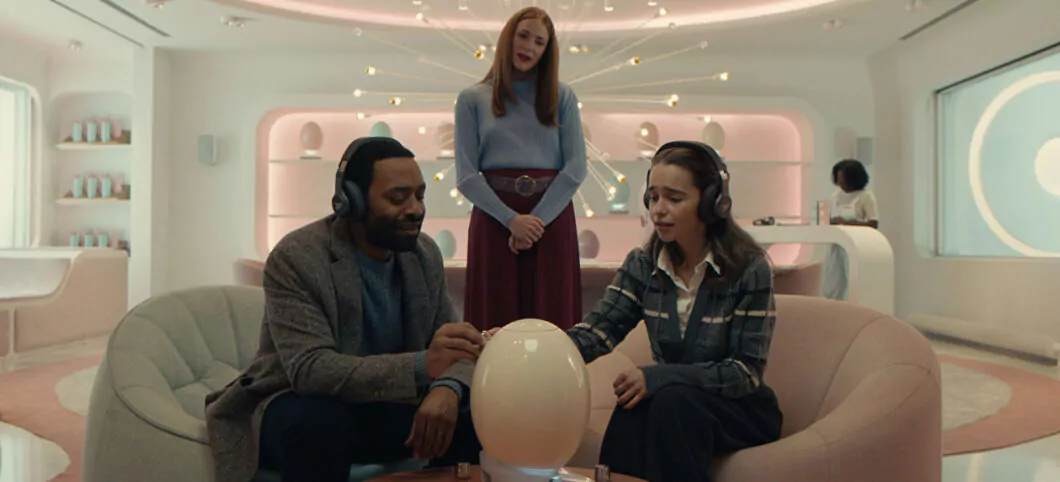
Set in the 22nd century amidst the backdrop of New York City, the Pod Generation tells the story of Rachel (Emilia Clark) and Alvy (Chiwetel Ejiofor) in an age where human lives are firmly under the sway of artificial intelligence. Personal AI voice assistants expertly schedule daily routines, and indoor artificial nature pods mimic outdoor experiences. Cutting-edge technology helps mothers have a child via artificial pods rather than undergo pregnancy.
The Pod Generation questions how much leverage man gives technology and whether it is justified. Siring a child from a pod is considered modern and convenient, but the reality is that the whole process could become extremely complicated, especially if the tech is run by businessmen fueled by the ambitions of profit rather than service. The sci-fi rom-com movie is a reminder of what awaits humanity, set in a somewhat dystopian world.
Summary of the Ending of The Pod Generation
The climax of The Pod Generation begins when Alvy steals their pod child from the Womb Center. They take their pod child to Shell Island, a place situated near the woods so that their child is born amongst nature. The baby becomes due when the couple goes to sleep following a long walk in the forests, highlighting how Rachel has dropped her fondness for modern tech.
A tune plays inside the child pod to signal the delivery. It asks for a conception code to obtain the child inside. Worse, the Womb Center remotely pulls off support for the pod. During this tense moment, Alvy decides to cut open the pod to get their baby. The audience’s worries about the child being accidentally hurt are reflected by Rachel’s worried expressions. Fortunately, the child is born alive and healthy.
In the end, Rachel travels to the Shell Island post office to send the broken artificial pod seemingly back to the Womb Center. The audience can feel her happiness as she cycles amongst a lush of trees and chirping birds. She decides to stay at the remote place instead of traveling to their AI-loaded home in New York, where their lives are ruled by modern-day technologies.
The Pod Generation (2023) Ending Explained
Prior to Alvy’s drastic step of theft, the movie captured the increasing distrust of Rachel and Alvy Novy about Pegasuz. Linda, the Womb Center representative, never mentioned that the pod child needs to undergo neurological sessions or that there could be complications after its birth due to hormones being left in the pod. Technology, which is aimed at making the world a cost-effective place, cost more than a natural birth in the Pod Generation.
Pod children became a class symbol, which allowed Pegazus to charge more money by manipulating the customers and the feminist ideals of ridding women of childbirth pains and labors. Productivity influenced the decisions of the company as they polished intelligent children from an early age to get incorporated into the corporate mechanisms while creativity and imagination took a backseat.
Alvy Novy cutting open the egg-shaped pod by holding the knife like a scalpel, similar to a Caesarean birth, indicated how some natural processes should not be mechanized in the Pod Generation. The tech-loving Rachel finally understood the reason why Alvy was concerned about nature in these changing times. In a world that produced hologram trees and plant life, Rachel ignored the world of artifice and took care of her child in actual nature.
Speed posting the stolen, broken pod symbolizes how the mother is expressing her defiance of the Womb Center. The film also hints that Rachel Novy won’t return to working for Pegazus. Alvy is not seen in the ending but he is the ultimate winner: proving that nature is not to be meddled with and must be preserved no matter how advanced the world gets. His lashing out at a co-worker who suggests trees to be replaced with holograms sums up the whole ‘nature versus artifice’ debate.
The recurring theme of motherhood is also seen in the movie. Rachel has dreams of giving birth to and caring for an egg rather than a child, terming the whole situation ‘weird.’ However, this is what she was doing in her life. Her lack of motherly instincts made her frustrated as she couldn’t feel attached to the pod child. After all, a baby in the womb is dependent and inseparable from its mother in the case of a natural pregnancy.
The Pod Generation Mid-Credits Scene Explained
Some 20 minutes into the movie, the CEO of Pegasuz claimed that the decreasing rates of childbirth were due to women not being able to compromise on their work life and health. He then introduced the pod child technology and played a major role in influencing Rachel’s need to have a baby. Jean-Marc Barr’s character is seen once again, this time in the mid-credits scene, making a more bewildering statement than the previous.
The CEO declares that Pegazus intended to allow babies to choose their parents in the future. While this may sound comical, it could be taken in all seriousness given that the Pod Generation movie featured AI-driven therapists, trees, and embryo fertilization in high-tech machines. This is how advanced human technology could dangerously get in the future.
We can only assume what the founder of the company meant. There might be some technology that allows the rapid growth and brain development of a child which will allow him/her to choose a guardian based on needs. AI could also show the best possible ‘matches’ for babies and adults. The overall surreal idea is that technology has reversed the parent-child dynamic.
The Movie Culture’s Synopsis
Writer/director Sophia Barthes has raised multiple thought-provoking questions on artificial intelligence, motherhood, and the loss of the natural in order to get more convenience. She also flips gender roles with the help of the pod child. Alvy views the pod as a “baby” and is more attached to it, taking care of it wherever he goes, while Rachel views the pod as “technology” and lacks the obvious connection that a mother has with a baby in her womb.
The Pod Generation also triggers feminist discourse on the subject of pregnancy at a time when test tube babies are slowly growing in popularity. Meanwhile, Barthes portrays our dependence on artificial intelligence and apps in a world where even the simplest tasks like making coffee is password password-protected.



